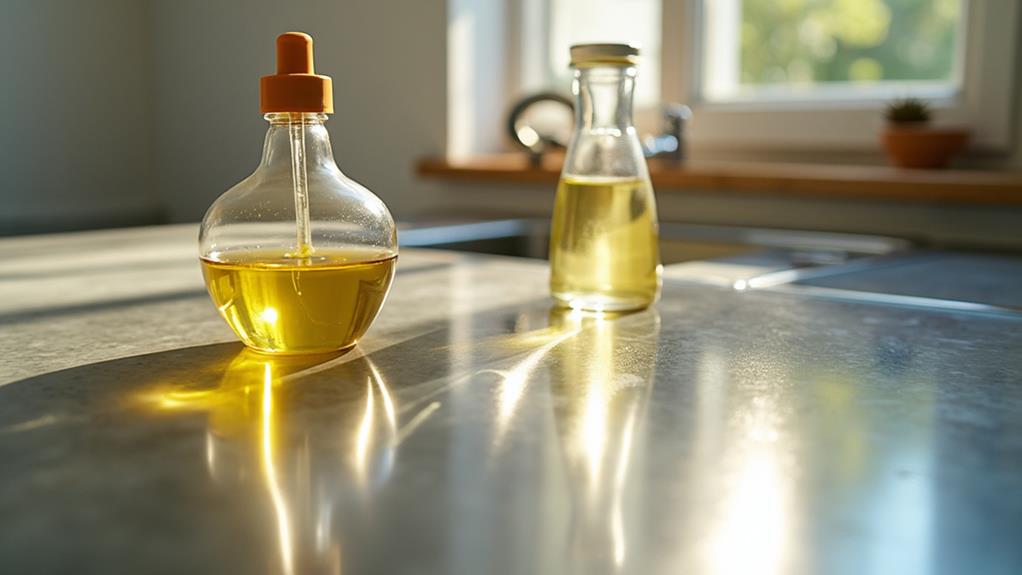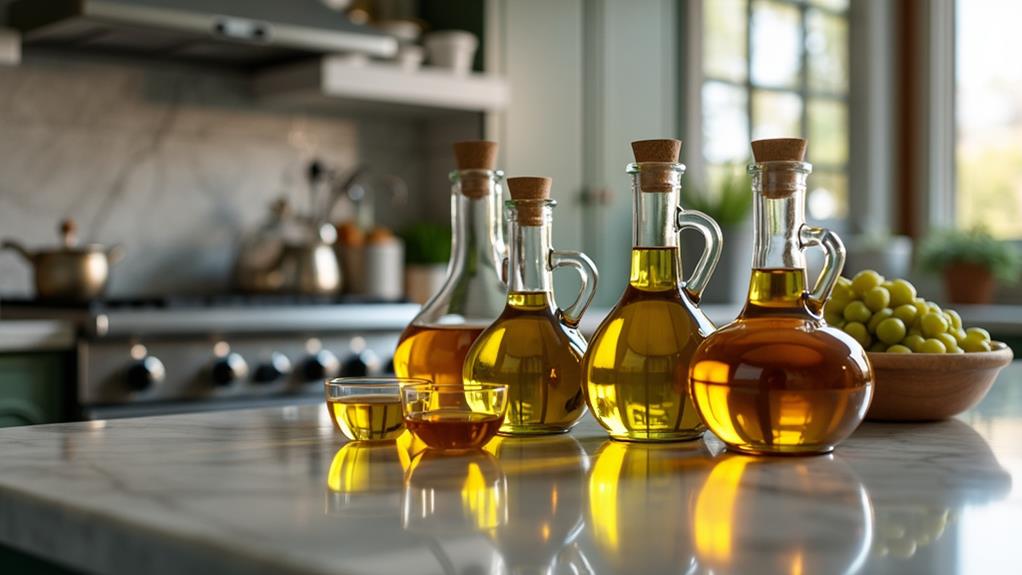Top 10 Tips for Caring for Stainless Steel With Mineral Oil
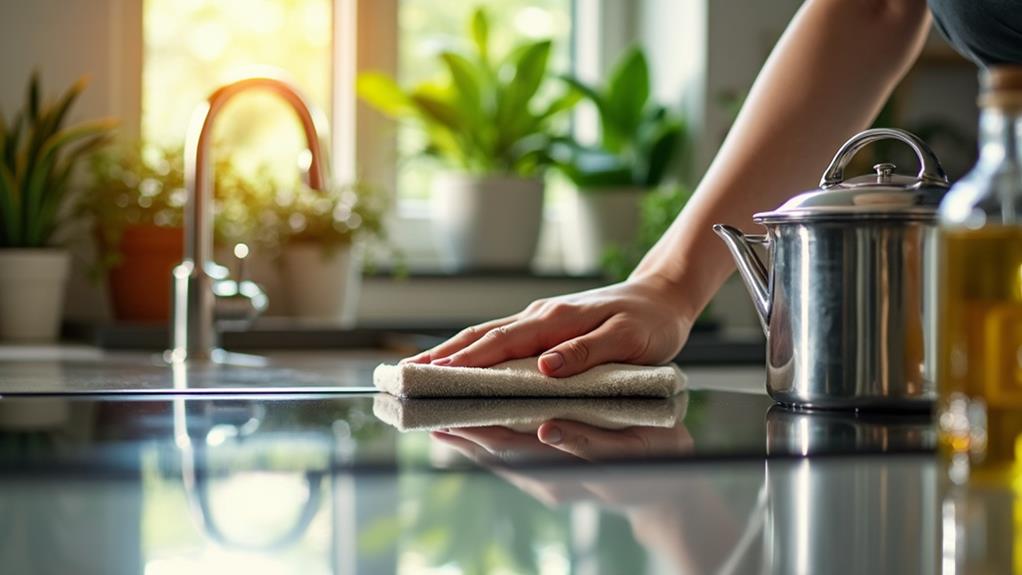
To keep your stainless steel appliances and surfaces gleaming, using mineral oil can be a game-changer.
Start by gathering the right supplies: a microfiber cloth and food-grade mineral oil. Properly clean the surface beforehand to remove any dirt or fingerprints.
Applying the oil and then buffing the surface will maintain its shine and create a protective barrier. Additionally, wiping in the direction of the grain is crucial for optimal results.
Let's explore why these steps are essential for your stainless steel care routine.
Gather Your Supplies
To effectively care for your stainless steel, start by gathering essential cleaning supplies. You'll need food-grade mineral oil, a microfiber cloth, and mild dish soap. These items are critical for maintaining the gleaming look of your stainless steel surfaces.
First, ensure your supplies are ready for routine maintenance. Food-grade mineral oil is excellent for adding a polished finish, while a microfiber cloth is perfect for applying the oil without scratching the surfaces. Additionally, having a separate clean, dry cloth for buffing is crucial to remove any excess oil and achieve a streak-free shine.
Before you start, consider using distilled white vinegar or a mild detergent solution to clean the surfaces. This step ensures that any grime or residue is removed, allowing the mineral oil to work more effectively.
When applying mineral oil, use a small amount to prevent greasiness. Dab it on the cloth rather than saturating it to ensure even application.
Keeping your cleaning supplies organized and accessible promotes consistent care, making it easier to maintain the pristine look of your stainless steel appliances. Consistent care and proper tools are key to preserving their shine.
Clean the Surface
To clean the surface, start by wiping it with a damp microfiber cloth to remove loose dirt. Use a mild dish soap and warm water mixture with a soft cloth to avoid scratches. For stubborn stains, soak the area with the soap solution for 20 minutes, then scrub gently with a non-abrasive sponge.
Choose Appropriate Materials
To maintain the pristine appearance of stainless steel surfaces, it is essential to use the correct materials and techniques. Always opt for a soft, non-abrasive microfiber cloth to prevent scratches and preserve the finish. For initial cleaning, mix mild dish soap with warm water to effectively remove grease and grime without damaging the surface.
Here's a quick reference table for your cleaning tools and techniques:
| Task | Recommended Material |
|---|---|
| Cleaning | Soft microfiber cloth |
| Soap Solution | Mild dish soap and water |
| Regular Inspection | Soft microfiber cloth |
Regular cleaning is vital for maintaining the aesthetic integrity of your stainless steel. Inspect the surface frequently for stains or smudges and address them promptly using gentle, non-abrasive methods. When using mineral oil, apply it sparingly with a clean cloth to enhance the shine and protect against fingerprints and water spots.
Avoid abrasive scrubbers or steel wool, as they can scratch the stainless steel and cause a dull appearance over time. By following these guidelines, you will keep your stainless steel looking pristine and extend its lifespan.
Apply Mineral Oil
A polished stainless steel surface exudes sophistication and cleanliness. To maintain this allure, regular application of mineral oil is essential.
Begin by thoroughly cleaning the surface to remove any dust, grime, or cleaning residue. This preparation step is crucial for optimal results.
Using a soft, lint-free microfiber cloth, apply a small amount of mineral oil. Avoid saturating the cloth; excessive oil can leave a greasy residue. Wipe the oil along the grain of the stainless steel to enhance its natural luster and prevent streaks.
Allow the mineral oil to sit for a few minutes, enabling it to penetrate and form a protective layer. Finally, buff the surface with a clean, dry cloth to achieve a polished finish.
Regular maintenance with mineral oil not only removes fingerprints and water spots but also helps resist future stains and tarnishing.
Apply Mineral Oil
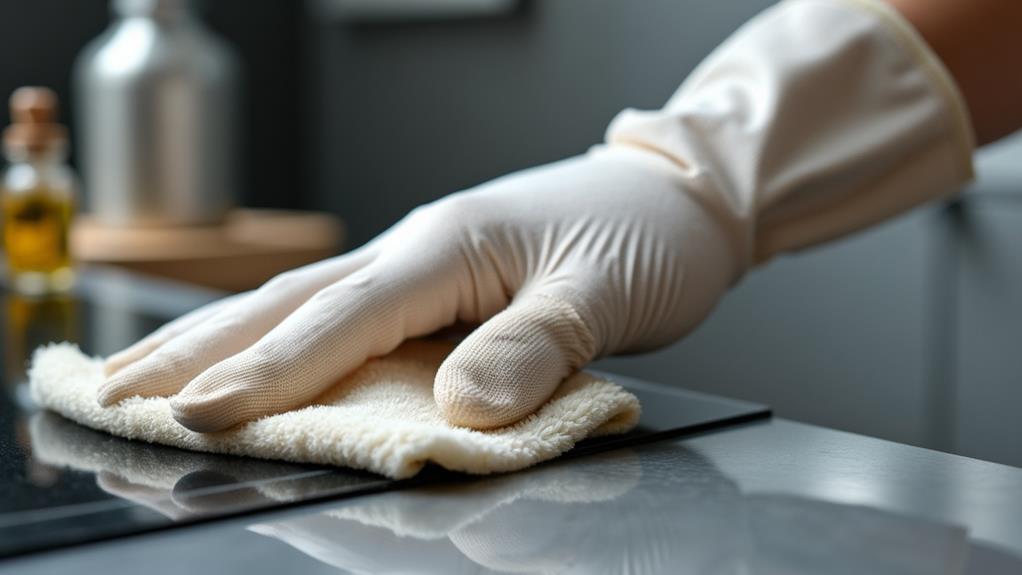
Applying mineral oil is an effective way to maintain your stainless steel surfaces. Start by grabbing a clean, soft microfiber cloth and applying a small amount of food-grade mineral oil. Avoid over-saturating the cloth, as too much oil can cause streaking.
Using a dabbing motion, apply the mineral oil along the grain of the stainless steel. This ensures even coverage and enhances the natural shine. Aim for a polished finish without leaving excess oil behind. Regular application, every few weeks, can help prevent fingerprints and water spots, while also providing a protective layer against future stains.
Before you begin, test the mineral oil on a small, inconspicuous area to ensure compatibility with your stainless steel finish, avoiding any unexpected reactions.
Once confirmed safe, proceed with the full application.
Buff the Surface
To achieve a brilliant finish on your stainless steel, start by buffing the surface with care. Apply a small amount of food-grade mineral oil to a clean microfiber cloth, ensuring not to saturate it to avoid streaks or residue. Buffing with mineral oil enhances the natural shine and creates a protective barrier against fingerprints and water spots.
Here are key steps to follow:
- Use a clean microfiber cloth to prevent scratches and achieve a streak-free shine.
- Apply a small amount of mineral oil to the cloth without oversaturating it.
- Buff in the direction of the grain to maintain a uniform appearance and prevent scratches.
- Regularly buff to restore luster and keep the stainless steel looking new.
A thin layer of mineral oil can effectively remove light soils and restore the luster of the stainless steel surface. This contributes to its longevity and reduces the need for extensive cleaning treatments.
Regular buffing with mineral oil ensures your stainless steel appliances maintain their pristine appearance, providing both aesthetic and functional benefits.
Wipe With the Grain
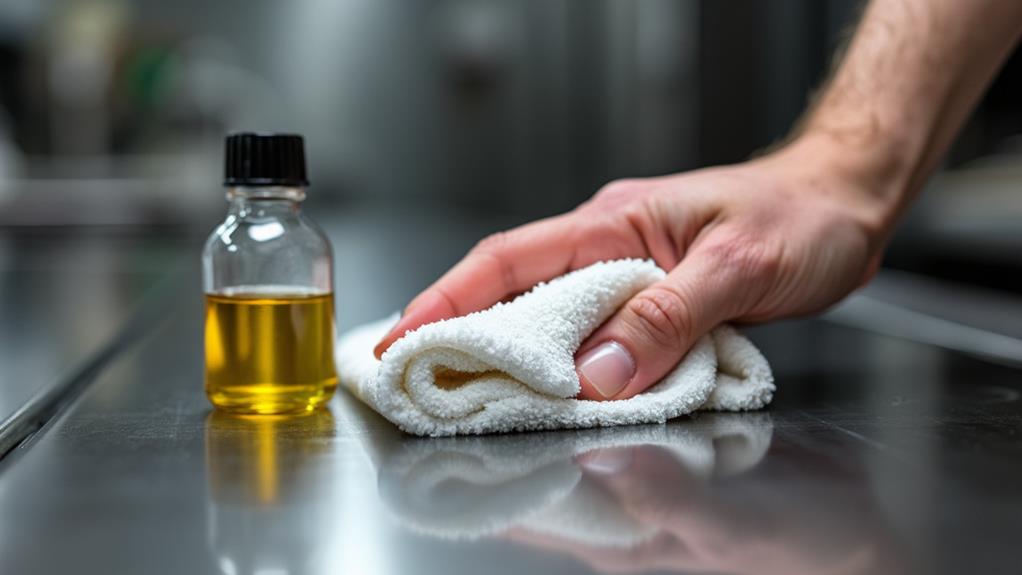
When cleaning stainless steel, always wipe with the grain to prevent streaks and maintain the surface's integrity. Follow the subtle pattern on the surface to enhance its natural shine and minimize scratches. Use a clean, dry microfiber cloth for best results and consider applying a bit of mineral oil for added protection.
Prevent Streaks Effectively
To effectively prevent streaks on stainless steel, pay attention to the direction of the grain. Wiping in the direction of the grain maintains the uniform appearance of the surface and reduces the likelihood of streaks.
For optimal cleaning, always use a microfiber cloth, which is gentle on the surface and highly effective at removing fingerprints and smudges without leaving scratches.
Using stainless steel cleaners can be beneficial if applied correctly. Here's how to prevent streaks effectively:
- Wipe in the direction of the grain: This ensures a streak-free finish and preserves the natural look of the stainless steel.
- Use a microfiber cloth: It's soft and reduces the risk of scratches while efficiently cleaning the surface.
- Apply mineral oil: A thin layer along the grain enhances shine and creates a protective barrier against future stains.
- Routine cleaning: Regularly clean with a damp cloth followed by a dry polish to minimize fingerprints and streaks.
Avoid using circular motions during cleaning, as they can create unsightly streaks and disrupt the natural finish.
Maintain Surface Integrity
Preserving the surface integrity of stainless steel relies on a simple yet crucial technique: wiping with the grain. Stainless steel surfaces have a specific grain orientation, and following this pattern is essential. Wiping against the grain can scratch the surface and dull its appearance.
To identify the grain, closely examine the surface; it runs either horizontally or vertically. Always use a damp microfiber cloth with a gentle cleaning solution, moving in the grain's direction to properly polish your stainless steel.
This method not only prevents streaks but also maintains the aesthetic appeal and longevity of your stainless steel items. A damp microfiber cloth is ideal because it effectively picks up dirt without causing damage. By wiping with the grain, you prevent buildup and ensure a smoother finish.
After cleaning, apply mineral oil to add an extra layer of protection. This step helps to deter fingerprints and smudges, keeping your stainless steel looking pristine.
Regularly following this method will keep your appliances and surfaces in excellent condition for years to come.
Enhance Natural Shine
Ever wondered how to make your stainless steel surfaces truly sparkle? One effective method to enhance the natural shine of stainless steel is by wiping with the grain. This technique not only prevents streaking but also highlights the surface's inherent luster.
Start by using a damp microfiber cloth with a small amount of mineral oil. Applying the oil in the direction of the grain ensures even distribution and maximizes the polishing effect.
Here's a quick guide to help you:
- Prevents Streaking: Wiping with the grain avoids streaks and uneven marks.
- Removes Imperfections: Regular polishing along the grain eliminates fingerprints and water spots.
- Reduces Scratches: Following the grain pattern minimizes the risk of scratches, preserving the finish.
- Achieves Reflective Finish: Buffing gently with a dry cloth enhances the shine to a brilliant, reflective finish.
This method guarantees your stainless steel surfaces will look their best, maintaining both beauty and durability.
Avoid Over-Application
Applying mineral oil to stainless steel surfaces can enhance their appearance, but it's important to avoid over-application. Excess mineral oil can leave a greasy residue that attracts dirt and dust, undermining the cleaning effort.
To prevent this, apply mineral oil sparingly in thin layers, using just enough to lightly coat the surface without saturating the cloth or appliance. Thin layers ensure even coverage and reduce the risk of streaking or buildup.
It's better to apply multiple thin layers than too much at once. Excessive mineral oil can create a slippery surface, posing safety hazards, particularly in kitchens and food preparation areas.
Test a small area first to determine the right amount and ensure compatibility with the stainless steel finish. This approach prevents over-application and keeps your surfaces pristine.
Proper use of mineral oil maintains the beauty and functionality of your stainless steel without unwanted side effects.
Use Food-Grade Oil
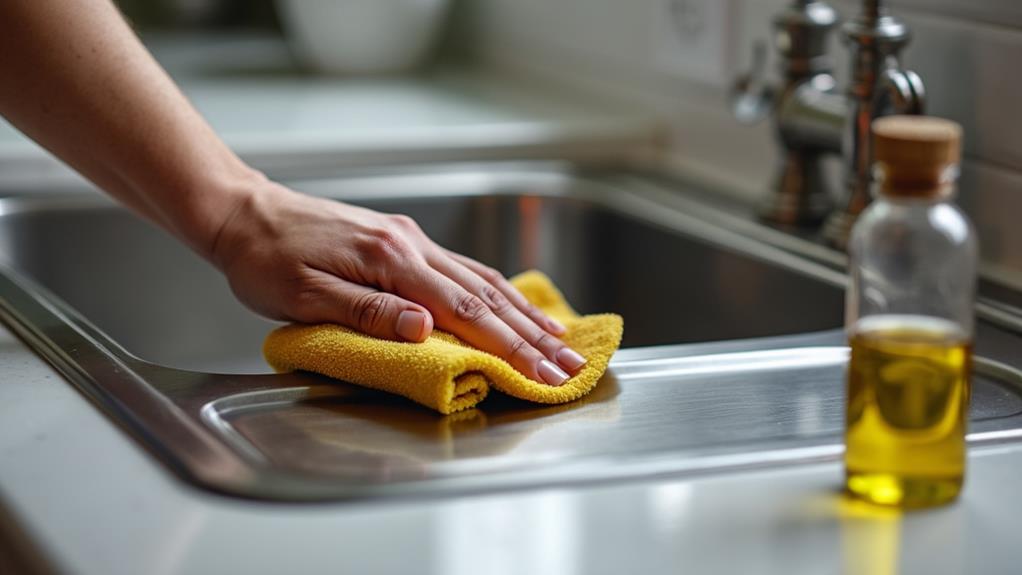
When caring for stainless steel surfaces and appliances in your kitchen, it's essential to use food-grade mineral oil to ensure safety and efficacy. Food-grade mineral oil is non-toxic and safe for use around food, making it the ideal choice for polishing and protecting stainless steel.
Applying food-grade mineral oil creates a protective barrier that helps prevent fingerprints and water spots, simplifying maintenance. This type of oil doesn't release harmful chemicals or odors, ensuring your food preparation areas remain safe and clean.
Regular use not only polishes the surface but also maintains its luster, prolonging the life of your stainless steel appliances.
Key benefits of using food-grade mineral oil include:
- Non-toxic and safe: Suitable for kitchens, providing peace of mind around food.
- Protective barrier: Prevents fingerprints and water spots.
- Polishing: Keeps stainless steel surfaces shiny and new.
- Maintains luster: Extends the life and appearance of your appliances.
Using food-grade mineral oil for your stainless steel surfaces is a straightforward and effective way to keep them in optimal condition. Regular application ensures your kitchen appliances stay pristine and function efficiently.
Maintain Regularly
To maintain the optimal appearance of your stainless steel, routinely wipe down surfaces with a damp microfiber cloth to prevent grime and fingerprints. Perform a deeper clean once a week using a mild dish soap solution. For added protection and enhanced shine, apply mineral oil monthly to guard against stains and water spots.
Daily Cleaning Routine
Consistency is key to maintaining the polished look of your stainless steel surfaces. Establishing a daily cleaning routine will help keep them looking their best.
Begin by wiping down the surfaces with a damp microfiber cloth to remove fingerprints and dust. For a deeper clean, use a solution of mild dish soap and warm water. Apply this with your microfiber cloth, then rinse with clean water to avoid soap residue buildup.
After cleaning, apply a small amount of food-grade mineral oil using a soft cloth. This will enhance the shine and create a protective layer against future stains. Always wipe in the direction of the grain to prevent streaks and maintain the stainless steel's appearance.
Completing this routine daily will prevent dirt and grime from accumulating, making weekly maintenance easier.
Here's a quick checklist for your daily routine:
- Wipe with a damp microfiber cloth to remove fingerprints and dust.
- Use mild dish soap and warm water for a deeper clean.
- Rinse with clean water to prevent residue buildup.
- Apply mineral oil with a soft cloth, wiping in the direction of the grain.
Weekly Oil Application
After establishing a solid daily cleaning routine, it's important to incorporate a weekly oil application to maintain your stainless steel's pristine condition. Applying mineral oil weekly helps maintain the shine of stainless steel surfaces by creating a protective barrier that repels fingerprints and smudges.
To start, take a clean microfiber cloth and apply a small amount of mineral oil. You don't need much—just enough to lightly coat the surface without leaving excess residue. This guarantees an even application without streaks.
Once your cloth is ready, wipe in the direction of the grain. This technique helps achieve a uniform appearance and enhances the natural luster of the stainless steel.
Regular weekly application of mineral oil can prevent the buildup of grime and tarnishing, thereby extending the lifespan of your stainless steel appliances. It's a simple yet effective way to keep them looking new.
Before you apply the oil to the entire surface, test it on a small, inconspicuous area. This precaution ensures compatibility with your specific stainless steel finish.
Store Oil Properly
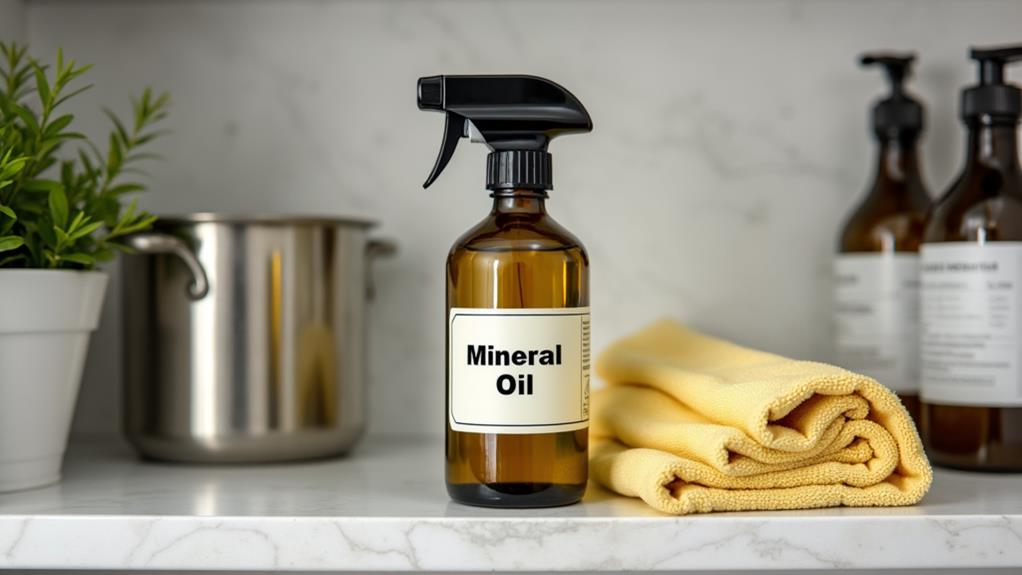
Proper storage of mineral oil is crucial for maintaining its quality and effectiveness in caring for your stainless steel items. Ensure the oil is stored in optimal conditions:
- Cool, Dry Place: Always store mineral oil in a cool, dry location away from direct sunlight. Exposure to light and heat can cause the oil to degrade, reducing its effectiveness.
- Sealed Container: Make sure the container is tightly sealed to prevent contamination and evaporation, ensuring the oil's quality remains intact.
- Material of Container: Use containers made from dark-colored glass or opaque plastic. These materials help shield the oil from light exposure, further preventing degradation.
- Safety Precautions: Keep mineral oil out of reach of children and pets to avoid accidental ingestion or spills, ensuring household safety.
- Check Expiration Date: Regularly check the expiration date on the mineral oil bottle. Using expired oil can lead to ineffective cleaning and may even damage your stainless steel surfaces.
Address Streaks
Streaks on stainless steel can be unsightly, but removing them is straightforward. Always wipe in the direction of the grain to maintain a uniform appearance and minimize visible marks.
After cleaning, polish the surface with a small amount of mineral oil using a microfiber cloth. This type of cloth is essential as it reduces the risk of scratching and enhances the shine. Ensure your cloth is clean and dry before polishing. A dirty or wet cloth can cause additional streaking.
For persistent streaks, spray a diluted solution of distilled white vinegar on the surface and follow up with a dry microfiber cloth to achieve a streak-free finish. Vinegar effectively cuts through residue and leaves the surface gleaming.
Conclusion
By following these top 10 tips, you can keep your stainless steel pristine and protected. Regular cleaning, proper application of food-grade mineral oil, and diligent maintenance will ensure your surfaces remain shiny and streak-free. Always wipe with the grain and store your supplies correctly. With minimal effort, your stainless steel will stay a beautiful and functional part of your home. Keep up the good work and enjoy the lasting benefits of well-cared-for stainless steel.

